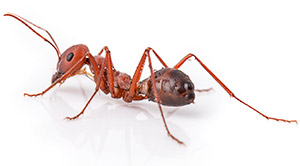
Facts, Identification & Control
Golden-yellow; one of the smallest ants, 1/16- to 1/8-inch long.
Thief ants derive their name from their habit of establishing colonies close to other ants to steal their food, and even capture and eat other ants’ eggs and larvae. They nest outdoors in soil, trash and rotten wood and tree cavities, and indoors in small crevices, woodwork and masonry. Finding the nests is extremely difficult, so thief ant control is best handled by professionals. Thief ants commonly enter structures during hot, dry weather.
Thief ants prefer high-protein foods, but will feed on sweets. They eat almost any organic matter, including insects, honeydew, seeds, meats, fruit, bread crumbs, oils, nuts, pet foods and dairy products.
Thief ant control can be difficult. They are often mistaken for the slightly larger pharaoh ants; unfortunately, the bait used for pharaoh ant control may not be effective for thief ants. The first step is to locate their nests, by following the trail of foraging workers back from their food source. An experienced ant control professional can tell you which different baits are likely to achieve best results.
"*" indicates required fields
Serving Ohio, Kentucky, Indiana

“Take care of the customers you have, and you’ll always have customers to take care of!”.
Your satisfaction is our goal. If you aren’t completely satisfied, we will work with you until you are.
Terry Teague - President of Extermital.